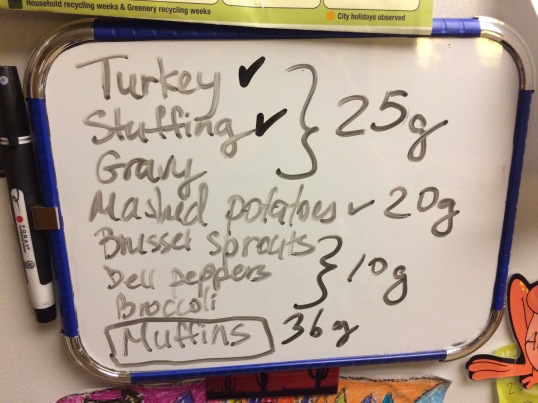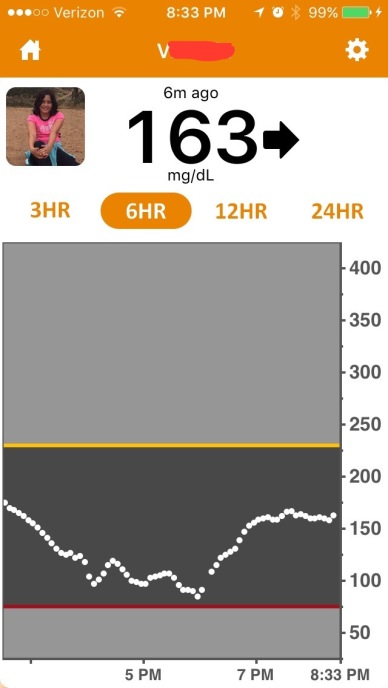I am pleased to report that this year we nailed Thanksgiving. It started with turkey. For so many years we kept over-cooking it. This year, with the help of a good meat thermometer, a LOT of butter, and more accurate info on when to pull the bird out of the oven, we ended up with a perfectly moist turkey cooked to perfection – dark meat and white meat. Nothing was over cooked and only a minuscule part was slightly over-cooked. Success!
But more importantly, we must have dialed up just enough magic to figure out carbs and insulin. It was very timely that I saw this article on diabetes and thanksgiving in the morning and immediately decided that I was going to use the tips. Because we are not afraid of insulin, no we are not!
At the heart of Scott’s strategy was this philosophy:
I have two steadfast rules about managing my daughter’s type 1 diabetes. Read them, memorize them, live by them.
1. It is far easier to stop a low or falling blood glucose then it is to return a high blood sugar to a safe range. In my experience most low or falling BGs can be stopped and steadied in a short amount of time, maybe 15 minutes. A high BG can take 3 to 5 hours to return to a safe place. I’ll say it again. It is easier to stop a fall or a low then it is to effect a high. This thought guides everything I do with insulin.
I can’t stress enough how much it resonated with me. And yet times and times again we’ve found ourselves acting way too cautiously, fearing lows, not using our CGM to keep better tabs on BG trends. NO MORE.
Last night I checked V over an hour before dinner and gave her a correction to bring her to a lower range. Then I looked at our menu and honestly calculated carbs. In fact, I decided to round up and assume that high-fat things will be metabolized as glucose, so that virtually nothing was carb-free. I did the math and decided that 100 g. was a good ball-park number.

I gave V her dinner bolus at least 3o min before dinner. She got 30% of insulin upfront and 70% spread out over 2 hrs, so that there would be active insulin in her system when all the delayed carb absorption started to happen.
The results were amazing. V’s BG stayed relatively steady. At some point after dinner and dessert I noticed that CGM was saying 91 and going down, so I let her have a small piece of candy. We had no lows and her BG topped at a little under 180! For us it is quite remarkable. Things were OK overnight, too. I gave V a small correction bolus before bedtime, and even though BG climbed up a little overnight, it again topped at 188. Typically, we’d be battling 200’s and 300’s and it was great to see V stay in a much better range.

Now, this is definitely something to be thankful for!
Wow! I love that advice. So frank and true. I hope I absorb it.
It’s especially silly to over-fear lows when you’re ALL TOGETHER, in one room, as a family, p,aging board games all night with a Dexcom right there on the table!
LikeLiked by 1 person
*playing
LikeLike
Exactly. I really hope this experience changes how we handle things at home around food. Yes, when we are out and about we may not have the same security or even opportunity to set things up in advance and keep a close eye on Dexcom. But at home? We’ve got to be more aggressive and proactive.
LikeLike
That is awesome! Congratulations!! My son hit the upper 200’s but, thankfully, was responsive to corrections since we increased the basal rate over night.
High protein meals are so tough. On our last Endo visit, our endocrinologist explained that every gram of protein is equal to half a gram of carbohydrate — over the following six hour period. I had never heard that formula per se but we are now experimenting with increasing basal rates by 25% over six hours after a high protein meal. Have you heard that before?
That advice from Scott about highs sounds right on! Thanks for sharing that. Thanksgiving is so difficult to manage. Always great to hear sound advice from other D parents!
LikeLiked by 1 person
I have not heard that formula either but at the TCOYD conference Dr. Pettus talked about dealing with high-protein and high-fat meals and his advice was similar. He said that you could bolus for extra carbs, or increase temp basal but about 10-30% for a few hrs. It makes sense to me and I think it’s a matter of trial and error to determine what works for each individual.
I was looking to see if I happened to snap a picture of the slide with recommendations but sadly I don’t have it. One slide that I do have says “Protein and fat gets absorbed slower and will EVENTUALLY require some insulin use. Expect to see the effect from these 1-2 hrs after eating (much delayed compared to carbs)”
LikeLiked by 1 person
This makes me so happy!
LikeLike
Thank you!
LikeLike